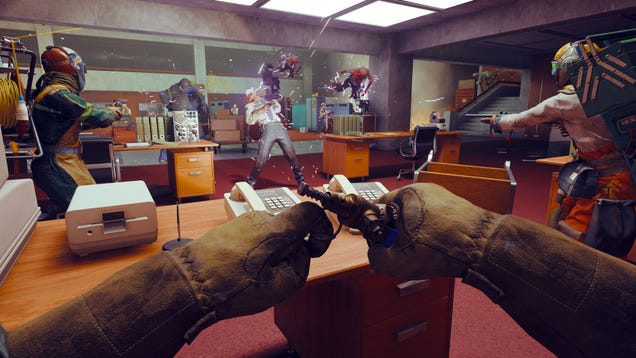In this explainer, Jack Wallen will not only explain Ollama, he’ll walk you through getting it running on your Linux box.
The post Ollama: Open Source AI That Runs on Your Computer appeared first on FOSS Force.

In this explainer, Jack Wallen will not only explain Ollama, he’ll walk you through getting it running on your Linux box.
The post Ollama: Open Source AI That Runs on Your Computer appeared first on FOSS Force.
Earlier this year, a biomedical researcher at the University of Michigan received an update from the National Institutes of Health. The federal agency, which funds a large swath of the country’s medical science, had given the green light to begin releasing funding for the upcoming year on the researcher’s multi-year grant.
Not long after, the researcher learned that the university had placed the grant on hold. The school’s lawyers, it turned out, were wrestling with a difficult question: whether to accept new terms in the Notice of Award, a legal document that outlines the grant’s terms and conditions.
Other researchers at the university were having the same experience. Indeed, Undark’s reporting suggests that the University of Michigan—among the top three university recipients of NIH funding in 2024, with more than $750 million in grants—had quietly frozen some, perhaps all, of its incoming NIH funding dating back to at least the second half of April.
Microsoft is positioning Windows as the primary gaming platform for Xbox, according to Xbox president Sarah Bond. “We’re working closely with the Windows team to ensure that Windows is the number one platform for gaming,” Bond said in a video announcing a partnership with AMD for next-generation Xbox hardware spanning consoles and handhelds.
The statement, PCWorld points out, aligns with Microsoft’s recent “This is an Xbox” marketing campaign, which promotes phones, PCs, televisions, and traditional consoles as Xbox devices. The company’s newly announced Xbox Ally X handheld runs Windows beneath its Xbox interface, allowing access to multiple game stores unlike Valve’s Steam Deck.
Microsoft has shifted strategy following weak Xbox console sales compared to PlayStation, spending billions to acquire publishers including Bethesda and Activision Blizzard while expanding Xbox Cloud Gaming services across multiple device types.
Read more of this story at Slashdot.
The blackout that took down the Iberian grid serving Spain and Portugal in April was the result of a number of smaller interacting problems, according to an investigation by the Spanish government. The report concludes that several steps meant to address a small instability made matters worse, eventually leading to a self-reinforcing cascade where high voltages caused power plants to drop off the grid, thereby increasing the voltage further. Critically, the report suggests that the Spanish grid operator had an unusually low number of plants on call to stabilize matters, and some of the ones it did have responded poorly.
The full report will be available later today; however, the government released a summary ahead of its release. The document includes a timeline of the events that triggered the blackout, as well as an analysis of why grid management failed to keep it in check. It also notes that a parallel investigation checked for indications of a cyberattack and found none.
The document notes that for several days prior to the blackout, the Iberian grid had been experiencing voltage fluctuations—products of a mismatch between supply and demand—that had been managed without incident. These continued through the morning of April 28 until shortly after noon, when an unusual frequency oscillation occurred. This oscillation has been traced back to a single facility on the grid, but the report doesn’t identify it or even indicate its type, simply referring to it as an “instalación.”
Released yesterday were X.Org Server 21.1.17 and XWayland 24.1.7 to address another batch of six security vulnerabilities reported by security researchers. Out today is X.Org Server 21.1.18 and XWayland 24.1.8 in order to further button up one of the security issues reported yesterday…
I’ll never say no to barbecue chicken or a snappy dog right off the grill, but grilled steak always feels like a special treat. Which steak, you ask? If you haven’t noticed, there are seemingly endless cuts of beef in the grocery store and at the butcher, and in my honest opinion, you can’t really go wrong. But no one likes that answer, so I’ll go over a few of my steak grilling tips, plus top four favorite steak cuts for grilling (in no order because my mood changes every day).

Grilling steak can be intimidating at first, but stick with it and you too will become a grill boss. The pressure might feel high, but even if you overcook the meat, a grilled steak is never ruined and can easily be used for a number of other dishes. I like the following cuts best for grilling because they’re versatile (can be sliced and served in a number of dishes), they have great beefy flavor, or because you get a lot of bang for your buck—and that means more steak nights this summer.
All steaks, unless you’re slow smoking some brisket, should be grilled fast (around three to six minutes per side depending on its thickness) and over the hottest area of your grill. Be sure to let it rest for about 10 minutes off the heat before slicing. There’s no real reason to slowly cook steak unless you’re trying to do a reverse sear. Personally, I’ve never done reverse searing on a grill because it’s less predictable than doing it in an oven or in the air fryer. Additionally, my primary reason for reverse searing is to reduce smoke indoors. When I’m cooking outside, the smoke doesn’t bother me. The stinging eyes and smoky laundry is all part of the experience.
A more affordable cut of meat, the flank steak is taken from the underside of the cow, in front of its hind legs. Essentially, it’s the cow’s six pack. And like mine, the cow’s abs are tough with less fat marbling. Less fat means more muscle grain and those will tighten up more and more as it cooks through. Additionally, flank steaks aren’t thick, so this is a quick sear. I like to throw it on the hottest part of the grill for maybe three minutes per side. It’s enough time to get some beautiful color and loads of flavor on the outside but just warm up the inside.
Since flank steak can be tougher, always slice your flank against, or perpendicular to, the muscle grain. Cutting across the “lines” will shorten the protein strands so it’s easier for you to chew, and that’s a much nicer eating experience. Read here for a step-by-step guide on grilling a flank steak. And when you have leftovers, try this recipe for cold flank steak with chimichurri sauce.
Another somewhat cheaper cut compared to other parts of the cow, the skirt steak comes from the area right above the flank steak, below the ribs. Skirt steak has similarities to flank—thinner cut and strong beefy flavor—but it usually includes more fat marbling. Think of the fat ribbons as breaking points in the strong chains of protein. That makes a piece of meat easier to chew because it readily separates at those points. This reads as tender to our palate, and that’s always nice.
Just like flank steak, skirt steak does well with a short and hot sear on the grill, and slicing it against the grain. I really love it thinly sliced with an herb-forward board sauce drizzled over the top, and it’s a great affordable replacement for ribeye when you’re making a cheesesteak—the bold flavor easily stands out against the bread.
Surprise! Who would have thought the porterhouse steak would be at home anywhere else but in a fancy mahogany and marble embellished steakhouse. I wouldn’t consider this a cheap cut of steak, but it is one of my favorites for tossing on the grill. I don’t do this for every weekend backyard grill session, but I visited my dad for his birthday last year and we took him steak shopping for lunch. I didn’t expect him to choose a porterhouse, but I was quietly impressed by his decision to let me buy him a $35 steak. How could I be grumpy when I knew I would be sneaking some slices off his plate?
We tossed that inch-and-a-half-thick cut on the grill for longer than the skirt steaks we bought, about five minutes per side, and carved it up for the table. Besides having great flavor and fat content, the porterhouse is actually composed of two different cuts: strip steak (my other favorite grilling steak) and tenderloin. The tenderloin. As in, the filet mignon section that everyone goes bonkers for. Filet mignon doesn’t have as much flavor on its own, but when paired up with the strip steak and the bone in the center of the porterhouse, you get a well rounded experience of flavor and a delicate bite.
The strip steak is my go-to steak for most cooking styles, not just grilling. It’s a great compromise between cost, flavor, and fat content. With a usual thickness of an inch or inch and a half, I also find that it’s more forgiving than skirt or flank steak when it comes to accidentally leaving it on the grill for an extra minute or so. You’re much less likely to ruin it, and the fat marbling can help keep it tender.
The strip steak comes from the short loin of the cow and it’s not a heavily used body part which makes it a more tender cut. I find it also works well with my budget but still feels like a treat. As I mentioned, strip steaks have a decent amount of fat marbling, so you get a thick, tender steak with plenty of flavor for roughly $12 to $16 a pound. When it’s not porterhouse week, you might find that a strip steak fits the bill. I usually toss a strip steak on the hottest, or near the hottest, section of the grill and give it about five minutes per side depending on the thickness.
Bummed because you bought a chuck steak or a flat iron steak? Don’t be. As long as you keep in mind timing, heat, and slicing against the grain, you’ll be in good shape. Thinner cuts of steak (less than an inch) need two or three minutes per side over the hottest heat, and thicker steaks need two to three more minutes per side (also on high heat). All you need now is a scoop of potato salad. And maybe some charbroiled oysters. Oh, and maybe three other dishes from this list.
During today’s Donkey Kong Bananza Direct, it was officially revealed that DK’s sidekick throughout the adventure is a young version of Pauline. That’s fun! Now let’s check the internet to see how people are reacting to the Direct… oh…oh no. Way too many of you care about Donkey Kong/Mario lore! That’s weird,…
Yesterday, Microsoft confirmed that it’s not abandoning the home console market just yet. In a short video teaser, Xbox President Sarah Bond highlighted a “strategic multi-year partnership with AMD” that will include “our next-generation Xbox consoles in your living room and in your hands.” But while we know that the “in your hands” part will include devices like the Windows-powered ROG Xbox Ally, there are still few specifics about what exactly Microsoft has planned for its future living room consoles (aside from what Bond calls “the next generation of graphics innovation”).
Reading between the lines a bit, though, we wouldn’t be surprised if Microsoft was getting ready to finally tear down the thinning wall separating gaming PCs and gaming consoles. A Windows-based, living room-focused Xbox capable of running generic Windows games could accentuate Microsoft’s strengths in PC gaming while papering over many of the company’s recent struggles in the home console market.
The once-bright line separating PC gaming and TV-based console gaming has been deteriorating for years. On the hardware side, bespoke console chips and development environments long ago gave way to PC-like architectures that are simpler and easier for developers to work with. And on the PC interface side, efforts like Steam’s Big Picture mode and SteamOS as a whole have strived to make playing on a PC with a handheld controller into a more console-like experience.
I Am Cat lets players roam free in a pirate map with friends in a new update.
One of VR’s most popular games that took the world by storm thanks to its inherently silly premise, I Am Cat, has now added a long-awaited multiplayer feature. As the name suggests, I Am Cat uses physics-based VR to its full advantage by putting you in the paws of a cat inside a grandma’s house. Having to move in a primal way a la Gorilla Tag, the goal of this game is simple but effective: to cause as much chaos as you can in this poor woman’s house.
 UploadVRIan Hamilton
UploadVRIan Hamilton
With this latest update, I Am Cat lets you connect with 19 other players in a fresh, pirate-themed map. With the primary objective to increase the mayhem that having 20 cats run wild implies, you and your fellow felines can engage in various fun activities. These flying interconnected ships work as a sandbox to offer snowball fights, fighting with medieval weapons, and other mini-game challenges to keep the online session lively. A piano to flex your musical abilities with others and a kitchen to cook treats for everyone around are some of the novel experiences to share with friends.
0:00
New cat cosmetics were also added to personalize your avatar. While character customization was already available in-game, these are further options to explore with this multiplayer update via in-app purchases. After this free update, developer New Folder Games has confirmed to expect more content soon.
Nintendo just dropped a ton of details about the next major Switch 2 first-party game. Donkey Kong Bananza was the star of a Nintendo Direct livestream this morning and it was filled to the brim with nifty tidbits to get fans excited about the 3D platformer.
The biggest news is the addition of Pauline as DK’s sidekick. She goes all the way back to the original Donkey Kong arcade game. Nintendo really pulled a fast one here, as the first trailer showed the sidekick as an anthropomorphic rock of some kind. This would be in line with Mario’s various partners in his 3D platformers, as he’s teamed up with hats, stars and other inanimate objects.
However, it was all a ruse. Pauline is the sidekick, as she was trapped inside of that rock. Nintendo really went all in with this prank. Even the original box art showed the little rock character, which has now been replaced by Pauline. There’s even a two-player co-op mode in which one person controls Pauline. This will work on GameShare, so it only requires one copy of the game.
WHILE IT HASN’T BEEN UPDATED ON SOME RETAIL SITES, NINTENDO HAS UPDATED THE BOX ART FOR DONKEY KONG BANANZA TO FEATURE THE REVEAL OF PAULINE INSTEAD OF THE ODD ROCK #SWITCH2 pic.twitter.com/nqKziSrPEO
— FAKE (@FakePearBear) June 18, 2025
There are some major lore implications here. Donkey Kong Bananza features Pauline as a kid and the Donkey Kong arcade cabinet starred her as an adult. This throws everything we know about the arcade game into question. Was Donkey Kong just protecting his surrogate daughter from the evil mustached plumber? Remember, Donkey Kong Jr. featured Mario as the antagonist.
It’s also worth noting that Pauline last appeared in Super Mario Odyssey, as the mayor of New Donk City. Did she create the city to honor her childhood hero? I have so many questions.
Pauline wasn’t the only cool thing that Nintendo revealed today. Donkey Kong Bananza has some light RPG mechanics, in the form of a skill tree. There are outfits to purchase for both DK and Pauline, which is always fun. DK can also turn into other creatures, offering the ape new abilities. Transforming into an ostrich inexplicably grants flight and turning into a zebra lets players run on water.
The trailer also placed a heavy emphasis on the destructive nature of the gameplay. We already knew that DK could destroy just about anything, leading to novel exploration methods, but that looks to be an even bigger part of the game than we thought. Remember how much climbing up anything changed the Zelda formula with Breath of the Wild? This is Donkey Kong’s take on that.
I love that amiibo aren’t dead yet ❤️
Donkey Kong Bananza amiibo ft. DK and Pauline pic.twitter.com/iOJreOWIbf
— amiibo Alerts (@amiiboAlerts) June 18, 2025
Finally, the game will make use of the Joy-Con’s mouse functionality. There’s a bonus mode where players can sculpt rocks via mouse controls. Donkey Kong Bananza is a Switch 2 exclusive that will be available on July 17. Nintendo is also prepping an Amiibo figure that stars both Donkey Kong and Pauline. This grants a new outfit for Pauline.
This article originally appeared on Engadget at https://www.engadget.com/gaming/nintendo/nintendo-just-revealed-pauline-as-a-surprise-character-in-donkey-kong-bananza-165132377.html?src=rss
The POSIX
realtime model, which is implemented in the Linux kernel, can ensure
that a realtime process obtains the CPU time it needs to get its job done.
It can be less effective, though, when there are multiple realtime
processes competing for the available CPU resources. The hierarchical
constant bandwidth server patch series, posted by Yuri Andriaccio with
work by Luca Abeni, Alessio Balsini, and Andrea Parri, is a modification to
the Linux scheduler intended to make it possible to configure systems with
multiple realtime tasks in a deterministic and correct manner.

Marvel has had some big wins and painful losses in the video game space over the past few years. Marvel Rivals took the hero shooter community by storm, and Marvel Tōkon: Fighting Souls is primed to be a fighting game powerhouse. On the other hand, Cliffhanger Games was shuttered while working on a Black Panther game…
It’s the end of the line for Beat Saber on PS VR and PS VR2. While you’ll still be able to buy and play the base game on both platforms, as well as any songs and music packs that were released before today (June 18), Beat Games is winding down support for those versions. They won’t get any new songs or music packs. As such, the final song that became available for Beat Saber on PS VR and PS VR2 was Lady Gaga’s “Abracadabra.”
Moreover, the PlayStation versions of Beat Saber will lose their multiplayer features on January 21 next year. Beat Games says that it will still provide customer support to players on those platforms.
“As we look to the future and plan the next big leap for Beat Saber, we have made the decision to no longer release updates for PS4 and PS5 starting in June 2025,” Beat Games wrote in a statement on X and its website. “Our passion for VR remains unwavering. We are excited about the possibilities that lie ahead and what we can bring to Beat Saber fans who have been on this journey with us over the past seven years.”
Beat Games announcement about PS4/PS5 support.
For more details, please visit our website: https://t.co/Vq4zGwcJGK pic.twitter.com/nCWxj2DndY
— Beat Saber (@BeatSaber) June 18, 2025
This change doesn’t impact the Steam VR version of Beat Saber. New songs, music packs and features are still coming to Beat Saber on Steam and Meta Quest platforms.
Meta bought Beat Games back in 2019. In effect, the company is ceasing Beat Saber development on platforms that do not support its own headsets
It’s most likely that Meta and Beat Games are ending their efforts on PlayStation versions of Beat Saber because they’re no longer seeing enough of a return on investment (though ending multiplayer support is an odd move). By all accounts, Meta Quest headsets have far outsold PS VR2 units.
It could be argued that Sony hasn’t fully gotten behind its own platform. By my count, there are fewer than two dozen PS VR2-exclusive games. The most recent State of Play stream featured only one (non-exclusive) game for the platform, Thief VR: Legacy of Shadow. So, it’s maybe not surprising that Meta is pulling the plug on Beat Saber on PlayStation’s VR headsets.
It’s still a shame though, as Beat Saber arguably remains one of the best VR games around, and maybe even the killer VR app. At this point, it might be best for PS VR2 owners who have a capable-enough PC and want more Beat Saber songs to pick up the PC adaptor and play the game on that platform. After all, Beat Saber is modable on PC (and Meta Quest), and there are thousands of custom song maps available.
This article originally appeared on Engadget at https://www.engadget.com/gaming/playstation/beat-saber-support-is-ending-on-ps-vr-and-ps-vr2-164136655.html?src=rss
Swiss Re has identified extreme heat as a significant insurance threat in its latest annual report on emerging risks with the Zurich-based reinsurer noting that up to half a million people globally die from extreme heat effects each year. The death toll exceeds the combined impact of floods, earthquakes and hurricanes. Heat waves contributed to conditions that generated $78.5 billion in insured wildfire losses globally from 2015-2024, Swiss Re reported.
The Los Angeles wildfires this year could add up to $45 billion in insured losses, according to UCLA Anderson School of Business estimates. The insurance industry has historically underestimated heat-related costs because damages spread across multiple policy types rather than appearing as a single category. Construction firms face rising medical insurance and workers compensation claims when outdoor workers suffer heat injuries, plus potential liability for inadequate cooling breaks.
Read more of this story at Slashdot.
The third Silent Hill movie is still heading to theaters. According to Deadline, Return to Silent Hill will premiere on January 23, 2026. The film is directed by Christophe Gans, who also helmed the original 2006 adaptation.
Return to Silent Hill is based on the 2001 game Silent Hill 2. (Bloober Team’s 2024 remake was one of our favorite games of the year.) The movie adaptation stars Jeremy Irvine and Hannah Emily Anderson. Akira Yamaoka, the game franchise’s original composer, handles the score.
Like the game it’s based on, the film’s protagonist is James Sunderland (Irvine). After a crushing breakup with Mary (Anderson), James lives up to the billing and… returns to Silent Hill. What he finds is a town transformed by a mysterious evil. As James searches for Mary, he faces terrifying creatures and unravels the truth. Psychological horror commences.
In 2022, Gans told IGN that it’s “totally independent” from the last two films. “Silent Hill is a bit like Twilight Zone, the Fourth Dimension, a place where anything and everything can happen,” he said. In an interview with Le Point, Gans added that he wrote the screenplay during pandemic lockdowns. “I shot it in early 2023,” he said (translated from French). “The film was supposed to be finalized in April 2024, but because of the executive producers, it dragged on, and I finished it last January.” (Shots fired.)
The movie doesn’t yet have a full theatrical trailer. But you can check out its 2022 teaser trailer below.
This article originally appeared on Engadget at https://www.engadget.com/entertainment/return-to-silent-hill-is-coming-to-theaters-next-january-163409009.html?src=rss
In a move that further intensifies the reflection of the cable business it’s slowly killing, Netflix will start showing broadcast channels next summer.
The world’s largest streaming provider announced today that starting next year, all Netflix subscribers in France will be able to watch broadcast channels from TF1 Group, France’s biggest commercial broadcaster, which also owns streaming services and creates content. Financial Times (FT) reported that users will be able to watch all five TF1 linear channels.
Netflix’s French customers will also gain access to “more than 30,000 hours” of on-demand TF1 content in the summer of 2026, FT reported. TF1’s content selection includes scripted dramas, reality shows like The Voice, and live sports.
GOG’s Preservation Program launched in late 2024 and the number of included games has doubled since the initial wave, currently sitting at 183. The latest headline-grabbing additions are the first four mainline Devil May Cry games and Mortal Kombat 1+2+3.
Devil May Cry: HD Collection was first released in 2012 and includes the first three entries in Capcom’s enduring action series, all playable in 1080p/60fps (a big deal at the time). Devil May Cry 4: Special Edition, which celebrates its 10th anniversary this year, has also been added. Add to these the Mortal Kombat trilogy and you’ve got major entries in two of the most influential series in their respective genres guaranteed to be compatible with modern hardware and protected against DRM.
The GOG Preservation Program pledges to ensure classic games remain playable beyond the point that their developers stop supporting them, safeguarding them for future generations to discover. As gaming moves even further towards an all-digital future, preservation remains a hot topic in the industry, with major publishers such as Ubisoft making a point of reminding players that they don’t technically own the digital games they purchase (see: The Crew 2 players).
Until July 2, you’ll be able to purchase the newly added Devil May Cry games as a bundle for 67 percent off. Here are the other games also joining GOG’s service this month.
This article originally appeared on Engadget at https://www.engadget.com/gaming/devil-may-cry-and-the-early-mortal-kombat-games-join-gogs-preservation-program-162641095.html?src=rss

It’s been over 25 years since Donkey Kong’s last 3D adventure, the ill-fated Donkey Kong 64 for Nintendo’s third-gen console. The good news is that Donkey Kong Bananza looks to be avoiding all the pitfalls of its predecessor, embracing the gameplay DNA of Donkey Kong Country mixed with the sandbox mechanics of a 3D Mar…

While we’re all waiting for Control 2, Remedy Games has released a multiplayer-focused game set in its universe, FBC: Firebreak. This game has a much wackier tone than Control. Whereas Control had protagonist Jesse Faden explore the psychological and supernatural elements of the Oldest House, here you and some friends…
Even in the age of TikTok, YouTube viewership continues to climb. While Google’s iconic video streaming platform has traditionally pushed creators to produce longer videos that can accommodate more ads, the site’s Shorts format is growing fast. That growth may explode in the coming months, as YouTube CEO Neal Mohan has announced that the Google Veo 3 AI video generator will be integrated with YouTube Shorts later this summer.
According to Mohan, YouTube Shorts has seen a rise in popularity even compared to YouTube as a whole. The streaming platform is now the most watched source of video in the world, but Shorts specifically have seen a massive 186 percent increase in viewership over the past year. Mohan says Shorts now average 200 billion daily views.
YouTube has already equipped creators with a few AI tools, including Dream Screen, which can produce AI video backgrounds with a text prompt. Veo 3 support will be a significant upgrade, though. At the Cannes festival, Mohan revealed that the streaming site will begin offering integration with Google’s leading video model later this summer. “I believe these tools will open new creative lanes for everyone to explore,” said Mohan.